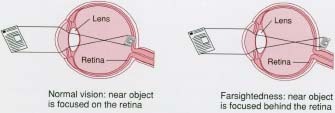Farsightedness
Farsightedness is an eye disorder that causes objects that are close to a person to appear out of focus or blurry, while objects at a distance may seem clear.
KEYWORDS
for searching the Internet and other reference sources
Hyperopia
Ophthalmology
Optometry
Vision
To people with farsightedness, the words on this page would seem blurry, unless they were wearing prescription (pre-SKRIP-shun) eyeglasses or contact lenses designed to correct the problem. But if they looked up from the page to read a sign across the room, they probably could read it easily.
What Is Farsightedness?
In most cases, farsightedness occurs when the eyeball is shorter than normal. For an object to appear clear, the light passing through the eye must focus on the retina, a layer of photosensitive * cells on the back of the eye. The retina is something like the film in a camera. It is where the image passing through the eye is projected and then sent along the optic nerve * to the brain. In the brain, the image is "developed" into what we see. If the eyeball is too short, the image that is projected onto the retina by close objects is blurred, and the person is said to be farsighted.
People with farsightedness usually have the disorder from birth. It is probably inherited from parents, although just because a parent is farsighted does not mean the child necessarily will develop the problem too. Babies and younger children often are able to adapt to the problem. Muscles around the eyeball can change its shape, which makes it longer and allows the image to be focused properly on the retina. But as a child gets older, the muscles cannot do as good a job changing the eyeball's shape, and images close up are out of focus.
How Do Doctors Diagnose and Treat Farsightedness?
It can take many years for the symptoms of farsightedness to become noticeable. Eventually, people with farsightedness notice problems while reading or seeing objects that are close, whereas things that are farther away remain clear. They also may start to get headaches after reading or doing other close work, and they may feel as if their eyes are tired.
Ophthalmologists * can diagnose farsightedness and correct it easily with prescription eyeglasses or contact lenses. These change the focus of the images passing into the eye so they are projected properly onto the retina. Surgery to correct the problem is available, but it is not as widely used as surgery to correct nearsightedness.
* photosensitive means responsive to light.
* optic nerve is the nerve that sends messages, or conducts impulses, from the eye to the brain, making it possible to see. The optic nerve is also referred to as the second cranial nerve.
* ophthalmologist (off-thal-MOLL-o-jist) is a medical doctor who specializes in treating diseases of the eye.
Presbyopia
Many people become more farsighted as they age. They develop a condition known as presbyopia (pres-be-O-pe-a), which is

* bifocal or multifocal (progressive) lenses are prescription eyeglasses that have lenses divided into two or more sections. The bottom section allows a person to see things clearly that are close, and the top section allows a person to see things clearly that are far away.
See also
Nearsightedness
Presbyopia
Resources
The U.S. National Eye Institute posts a resource list of eye
health-related publications and organizations at its website.
http://www.nei.nih.gov/publications/sel-org.htm
American Academy of Ophthalmology, P.O. Box 67424, San Francisco, CA
94120-7424. The American Academy of Ophthalmology website includes a
search engine that locates information about many disorders of the eye.
Telephone 415-561-8500
http://www.eyenet.org
Comment about this article, ask questions, or add new information about this topic: